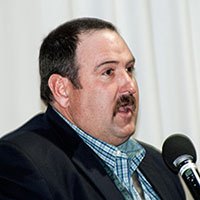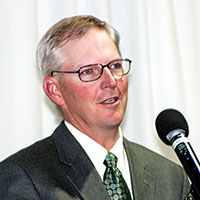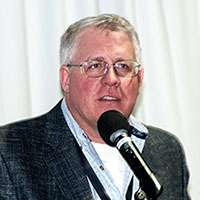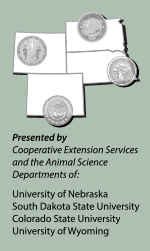Producer Panel:
Cow Feed Efficiency
Three cattlemen share what defines efficiency, profitability within their operations.
LOVELAND, Colo. (Nov. 17, 2015) — Feed efficiency among beef cattle is a complex issue with genetic, environmental and managerial components. How feed efficiency among feedlot cattle consuming high-energy diets relates to feed efficiency among foraging range cattle is not well-understood. During the 24th semi-annual Range Beef Cow Symposium Nov. 17-19 in Loveland, Colo., a panel of three successful cattlemen shared their views on cows that are efficient and, moreover, profitable.

Trey Patterson
Beginning the discussion was Trey Patterson, who presides over Padlock Ranch Co. operations in northern Wyoming and southern Montana. Saying that the most productive cattle in terms of output are not always the most profitable, Patterson described the biological type of cow exhibiting economic efficiency in the Padlock’s restricted feed environment as moderate for both mature size and milk production.
In an attempt to “build a better cow” for that environment, Patterson said, emphasis is placed on converting feed resources into long-term reproductive success and controlling the costs of producing a weaned calf that satisfies customer expectations. He questioned the wisdom of developing replacement heifers in a feedlot, in terms of cost and long-term reproductive performance of females added to the breeding herd. The ranch is tracking the long-term performance of heifers developed on native range, for comparison with the performance of feedlot-developed heifers.
Citing multiple sources of research data and the ranch’s experience thus far, Patterson said, “We believe that, in our system, it may be more advantageous to range-develop our replacement heifers.”

Douglas Olsen described his family’s western-Nebraska operation, which markets harvest-ready cattle and seedstock born to its commercial and purebred herds.
Following Patterson, Douglas Olsen described his family’s western-Nebraska operation, which markets harvest-ready cattle and seedstock born to its commercial and purebred herds. Olsen Ranches also offers custom-feeding services and conducts progeny testing. Individual feed intake data is collected on the ranch’s own cattle, as well as for customers. Olsen said his experience suggests that the effects on feed efficiency of grain diets vs. forage diets are not exactly the same, but they are not far different.
Using lifetime production records and photographs of cows from his own commercial herd as examples, Olsen said, “You can’t see the differences between more- and less-efficient cows. You can’t tell by looking. Mature weight was not a factor with these cows.”
Olsen said there remains much potential for genetic improvement of production efficiency and specifically feed efficiency. Through genomics and continued progeny testing, including collection of feed intake data, he believes opportunity to increase overall production efficiency can be realized.

Colorado seedstock producer Lee Leachman.
Rounding out the panel of speakers was Colorado seedstock producer Lee Leachman, who warned producers against obsessing over feed efficiency. It’s not that it isn’t important, but Leachman likened an excessive emphasis on feed efficiency to single-trait selection.
“It doesn’t work to continue selecting for excessive growth, milk production, postweaning gain and carcass traits, because cost of production goes up and up,” said Leachman. “As a result, we have been selecting for cows that eat more. We should be doing the opposite, so we can run more cows by stocking more heavily.”
Leachman suggested that cow-calf producers should base genetic selection on the goal of increasing profit per acre. The ability to run more cattle on the same or less acreage makes revenue go up and costs go down, thus increasing opportunity for profit.
According to Leachman, running smaller, low feed intake cows allows a rancher to increase stocking rates. Their calves may not be as big, he admitted, but the total pounds of calf weaned per acre will be greater than when a ranch must support fewer, larger, high-intake cows. Additionally, Leachman emphasized the advantages of heterosis, saying crossbred cows also wean more calves during their lifetimes.
Editor’s Note: This summary was written under contract or by staff of the Angus Journal®, which retains the copyright. To request to reprint this article, contact Shauna Rose Hermel, editor, at 816-383-5270. PowerPoints are posted with permission of the presenter and may not be reproduced in whole or in part without the express permission of the presenter. Angus Journal claims copyright to this web site as presented. We welcome educational venues and cattlemen to link to this site as a service to their audience.
The Angus Journal's coverage of the event is made possible through collaboration with the event committee and sponsorship of LiveAuctions.tv. For questions about this site, or to notify us of broken links, click here. Look for additional coverage in the Angus Journal, the Angus Beef Bulletin, the Angus Journal Daily, the Angus Beef Bulletin EXTRA and Angus TV.


